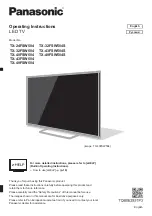
Circuit Descriptions, Abbreviation List, and IC Data Sheets
EN 107
A02U AA
9.
Digital Multi Standard Decoder (DMSD)
This DMSD block contains the following functionality:
•
Decodes a CVBS or Y/C (primary VIDDEC) signal and
converts it to an YCbCr signal format. All world color
standards are supported.
•
YC detection (primary VIDDEC) via a SW algorithm.
•
50/60 Hz, interlace/progressive, field polarity, and no-YC
detection.
•
A chroma notch with programmable width.
•
2D Comb filter (primary VIDDEC). The 3D Comb filter uses
the attached SDRAM memory and is implemented in the
FBX.
•
Macro vision detection.
Comb Filter
The ADOC 2D comb works purely in the vertical direction, but
can bypass the entire signal as luminance straight away. The
2D comb uses the 180 degrees phase shift of the color carrier
between successive lines or two lines apart. Adaptive two or
four delay lines 2D Y/C comb filtering is only possible for
sources routed onto the Main-Video path.
In the 3D comb filter implementation (for USA only), the 2D
comb filter processing in ADOC IC (on the Main-Video path) is
disabled via SW. The signal input for the 3D YC comb-filter
circuit is derived from the CVBS-SC2_MON-OUT signal path.
The processed signal is re-inserted back via YCOMB and
CCOMB inputs of the MPIF IC.
The 3D Comb filter is integrated in one IC (type uPD64083).
The block diagram of the 3D Comb panel is indicated in the
next figure (re-use of R8 manual, does not reflect the actual
circuit exactly).
Figure 9-12 Block diagram 3D comb filter
Standard Detection
The Standard Detection part identifies PAL/NTSC/SECAM/BW
but also involves Horizontal and Vertical sync identification
(both 1fH and 2fH) as well as YC detection (via a SW
algorithm).
YUV Multiplexer
The YUV mixer selects between the YUV output of the DMSD
and 1fH component video input signals (RGB, YPbPr) or 2fH
input signals (RGB, YPbPr, ATSC). The YUV mixer can also be
controlled via a fast blanking input (SCART) to insert RGB
signals, such as descrambler OSD or full RGB insertion of DVD
players.
When a 2fH input signal is selected as an input, the complete
primary VIDDEC is running at 2fH (54 MHz), including DMSD
(in this scenario, the DMSD cannot be used any more for CVBS
input signals, and as such, VBI data slicing cannot be done).
Feature Box
The Feature Box (FBX) in the ADOC can be divided into three
functional parts: The front-end features (FEF), memory-based
features (MBF), and back end features (BEF).
The FEF part of the FBX implements all signal analysis
functions as well as black stretch and histogram correction.
The MBF part applies spatial scaling, temporal noise reduction
and up-conversion to either progressive scan or a double field
rate (100 Hz).
The BEF part implements spatial picture enhancement
functions like sharpness and color enhancement functions,
sharpness measurement and horizontal scaling and panorama
The FBX has two video inputs coming from VIDDDEC 1 and 2,
and outputs one RGB video stream to the display output
processor (DOP).
The following sections describe the three functional parts of
FBX in more detail.
Front End Features (FEF)
The FEF consists of several signal analysis functions (HME,
BLD, BBD, NEST), histogram correction (HMO) and black-
stretch (BS). Following figure shows the functional block
diagram of the video frond-end features (FEF). All signal
processing in the FEF is nine bits based.
The FEF has two video inputs coming from the VIDDECs. For
every block, one video source can be chosen as input,
independently for every block. The FEF has two video outputs,
designated as "main" and "sub".
Histogram modification can only be performed on the main
channel; therefore, the HME block is general connected to the
same video source as the main channel. Besides the two
VIDDEC inputs, there is also a third virtual input, the "blanking"
input. Only main and sub can be connected to this blanking
input, and at the same time, it can be specified which sync
source has to be used (VIDDEC1 or VIDDEC2).
Figure 9-13 FEF block diagram
When a single stream is displayed, the main output is used for
this stream. Also, all signal analysis functions should be
connected to the same VIDDEC as the main channel is
connected to.
When two streams are displayed, then there are two user
scenarios: Picture In Picture (PIP) and Double Window (DW).
In the PIP scenario, the full screen picture is displayed via the
main channel, and the PIP stream is switched to sub. In the DW
scenario, selection of the video sources for main and sub
depends on if the two streams have a different vertical
resolution and how the system has to cope with this difference.
CVBS Input
Amp & Filter
Y Output
Amp & Filter
C Output
Amp & Filter
Video Clamp
and Filters
NEC
PD64083
Sync
Amp
Power On
Reset
Xtal
PLL Filter
Memory Supply
Decoupling
Digital Supply
Decoupling
Analog Supply
Decoupling
2.5 V Reg
3.3 V Reg
8.0 V Filter
+8.0 V
+2.5 V
+3.3 V
+5.0 V
+8.2 V
+2.5 V
+3.3 V
Y to HIP
Input
CVBS From
HIP Output
C to HIP
Input
+8.0 V
From Main
Chassis
Supplies
+8.0 V
84
50
52
48
47
76
57
83
88
CL 26532058_016.eps
050602
CL 36532058_069.eps
071003
INPUT
SWITCH
MATRIX
BLACK
STRETCH
BLACK
STRETCH
HISTOG.
MODIFY
HISTOG.
MEAS.
BLACK
BAR DET.
BLACK
LEVEL DET
NOISE
MEAS.
MEASUREMENT
BLOCKS
VIDDEC1
VIDDEC2
MAIN
CH.
SUB
CH.
ADOC FEF
(YUV)
(YUV)
SAMPLE
RATE
C
O
N
VERTER
B5
7300
Содержание A02U AA
Страница 41: ...Circuit Diagrams and PWB Layouts 41 A02U AA 7 Layout LSP Part 1 Bottom Side PART 1 E_13950_035a eps 240304 ...
Страница 42: ...42 A02U AA 7 Circuit Diagrams and PWB Layouts Layout LSP Part 2 Bottom Side PART 2 E_13950_035b eps 240304 ...
Страница 44: ...44 A02U AA 7 Circuit Diagrams and PWB Layouts Layout LSP Part 4 Bottom Side E_13950_035d eps 240304 PART 4 ...
Страница 88: ...88 A02U AA 7 Circuit Diagrams and PWB Layouts ...
Страница 117: ...Spare Parts List EN 117 A02U AA 10 10 Spare Parts List Not applicable ...
Страница 118: ...Revision List EN 118 A02U AA 11 11 Revision List First release ...












































